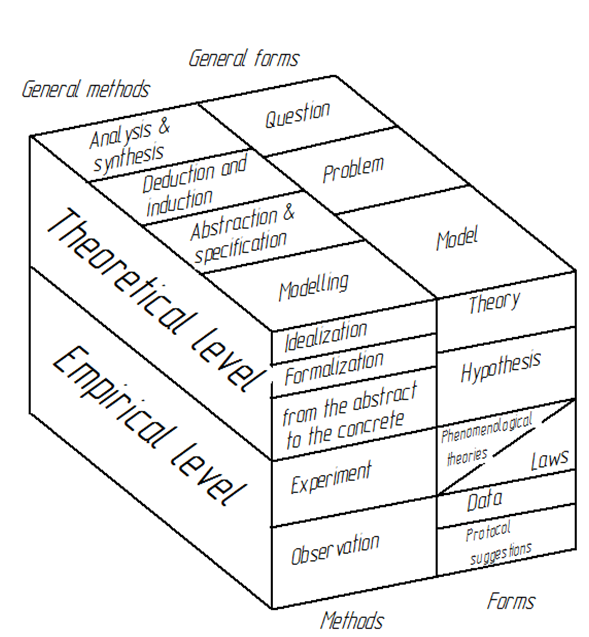INTRODUCTION
Every single day we meet the products of scientific research, and sometimes we do not notice them immediately. Many things in the up-to-date world have been made during a long way of research by minds of scientists and hands of engineers and workers. And, no doubt, that science has been playing a unique role in such process since the dawn of the first primitive attempts of calculation and thinking of. Nowadays it is hardly believed that we can neglect products of scientific research and come back to ancient dark times. Thus, scientists of the world keep on doing research while inventors try to invent something novel and engineers construct new things such as bridges, aircraft, smartphones, etc.
If a scientist understands research and its relationship to science and knowledge, it is sometimes difficult especially for young students to get an idea of these three pillars of thinking process based on which we can move ahead and get better results by improving our life and avoiding many problems.
SCIENCE, KNOWLEDGE, RESEARCH
There is a problem while counting on what difference is between science, knowledge and research. For example, here are some common definitions of science as:
- a special branch of knowledge or study dealing with a body of facts or truths systematically arranged and showing the operation of general laws;
- systemic knowledge of the physical or material world gained through observations and experimentation;
- systematized knowledge in general;
- any of the branches of natural or physical sciences;
- a particular branch of knowledge;
- knowledge, as of facts or principles; knowledge gained by systematic study;
- skills, especially reflecting a precise application of facts or principles; a kind of proficiency.
Altogether with science definition it is interesting to focus on research itself. Generally, research can be understood as a special process that is not immediate and quick, thus scientists are forced to keep up patience and wait until a final step appears and shows whether the taken hypothesis was right or absolutely wrong. In the broadest sense of the word, the definition of research includes any gathering of data, information and facts for the advancement of knowledge. Research is “creative and systematic work undertaken to increase the stock of knowledge” [1]. It usually involves collection, organization, and analysis of information to increase understanding of a topic or an issue. A research project may be an expansion on past work in the field. Research projects can be used to develop further knowledge on a topic, or for education. To test the validity of instruments, procedures, or experiments, research may replicate elements of prior projects or the project as a whole thing [2].
What about knowledge, it is a familiarity, awareness or understanding of someone or something, such as facts, information, descriptions, or skills, which is acquired through experience or education by perceiving, discovering, or learning. Knowledge can refer to theoretical or practical understanding of a subject. It can be implicit (as with practical skill or expertise) or explicit (as with the theoretical understanding of a subject); it can be more or less formal or systematic. In philosophy, for example, the study of knowledge is usually called epistemology. The worldwide philosopher Plato famously defined knowledge as “justified true belief”, though this definition is now agreed by most analytic philosophers to be problematic because of the Gettier problems.
In common, knowledge acquisition can involve complex cognitive processes such as perception, communication, and reasoning, while knowledge is also said to be related to the capacity of acknowledgment in human beings.
In general, it should be said that scientific knowledge is interesting and attracts much attention because it keeps treasure an owner of which can get lots of benefits and improve life by using new inventions and achievements of science.
THE 3D BLOCK OF SCIENTIFIC KNOWLEDGE
Figure 1 shows a created 3D block of the scientific knowledge structure that includes two levels and looks like a pie having several parts.

Fig. 1. A new representation of the scientific knowledge structure as the 3D block having two main levels and including methods and forms
Looking at this new presentation of the scientific knowledge structure it would be useful to repeat main methods and forms. General methods include analysis and synthesis, deduction and induction, modelling, abstraction and specification. General forms include question, problem, model. Methods of empirical level are observation and experiment, and methods of theoretical level are idealization, formalization, a way from the abstract to the concrete. Forms of empirical level are protocol suggestions or facts, data, laws and phenomenological theories. Forms of theoretical level are hypothesis and, of course, theory [3].
It is evident that such 3D demonstration of the scientific knowledge structure inevitably leads to much better understanding especially amongst young researchers who have just begun first steps in science but previously never worked with scientific investigations.
In addition, it is expected that the shown 3D block of the scientific knowledge structure will change, perhaps, increased in future a little if new forms or methods appear afterwards. All in all, such presentation seems to be like a good example and a strong basis for further scientific research in spite of any branch of science or technologies.
CONCLUSION
Thus, the new representation of the scientific knowledge structure has been successfully made in a form of the 3D block that has empirical and theoretical levels. No doubt, such vision will help students and young researchers to understand all the methods and forms of the scientific knowledge much better.
References
-
OECD (2015). Frascati Manual. The Measurement of Scientific, Technological and Innovation Activities. doi:10.1787/9789264239012-en. ISBN 978-9264238800.
- https://en.wikipedia.org/wiki/Research
-
Solodukho, N.M. (2006). The Systematic Course of Philosophy: The Quintessence. Tutorial. Kazan, Kazan State Technical University, 106 p.
